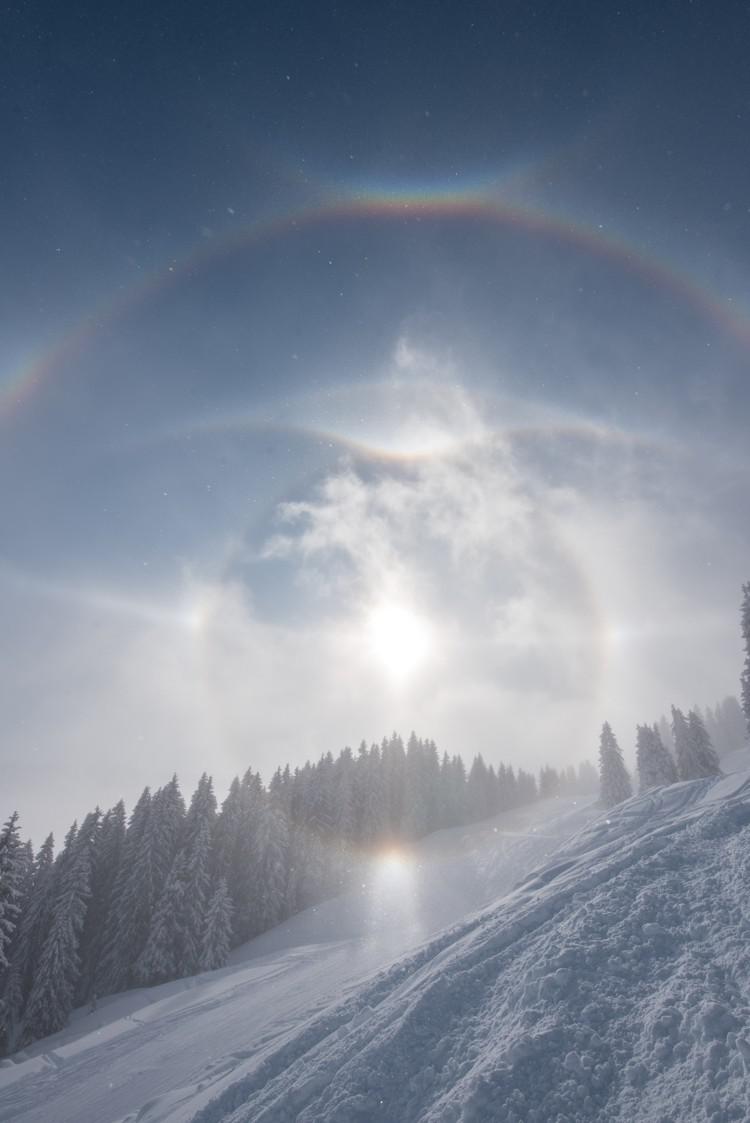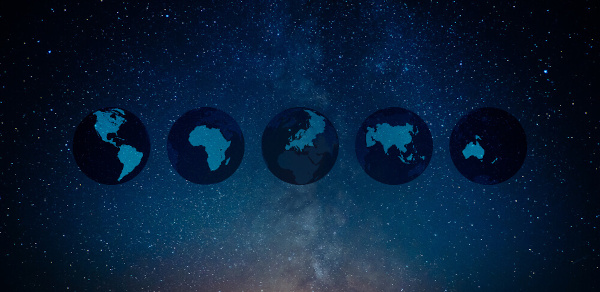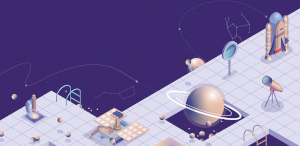This page describes an image Winter Haloes, by Thomas Gigl, Germany
Image caption:
Second place in the 2021 IAU OAE Astrophotography Contest, category Sun/Moon haloes.
Captured in Jochberg located in the famous Austrian ski-region of Tirol, this image shows multiple features related to ice halos, which are a more common appearance around the sun, due to its brightness, than the moon. External and internal reflection of sun rays from ice crystal faces and within different types of ice crystals lead to these halo related phenomena. The 22° halo encircles the sun, with two bright spots at the edge called Sundogs, Parhelia or Mock Suns observed to the left and right at the same height as the sun. The horizontal white band called the parhelic circle, named after the sun god Helios, passes through the sun and the Sundogs at the same angular elevation. An Upper tangent arc, a suncave parry arc and a lower tangent arc are also seen touching the top and bottom of the 22° halo. An upside down rainbow like arc or the circumzenithal arc is seen touching the bright supralateral arc, both of which are less frequently observed.
Scroll to captions in other languages
Image credit:
Thomas Gigl/IAU OAE
DOI: 10.5281/zenodo.5418795
Related glossary terms:
Halo
, Sun
Categories:
Naked Eye Astronomy
, The Sun
Image license: Creative Commons Attribution 4.0 International (CC BY 4.0) Creative Commons Attribution 4.0 International (CC BY 4.0) icons
The media file captions presented on the OAE website were written, translated and reviewed by a collective effort from the OAE, the OAE Centers and Nodes, the OAE National Astronomy Education Coordinators (NAECs) and other volunteers. You can find a full list of credits for our translation project here. All media file captions are released under a Creative Commons CC BY-4.0 license and should be credited to "IAU OAE". The media files themselves may have different licenses (see above) and should be credited as listed above under "credit".
If you notice a factual error in this caption or an error in any of its translations then please get in touch.
Captions in Different Languages:
Image caption: ২০২১ আইএইউ ওএই অ্যাস্ট্রোফটোগ্রাফি প্রতিযোগিতায় দ্বিতীয় স্থান, ক্যাটাগরি সূর্য/চাঁদ হ্যালো।
তিরোলের বিখ্যাত অস্ট্রিয়ান স্কি-অঞ্চলে অবস্থিত জোচবার্গে ধারণ করা, এই ছবিটি বরফের আলোর সাথে সম্পর্কিত একাধিক বৈশিষ্ট্য দেখায়, যা চাঁদের তুলনায় সূর্যের চারপাশে তার উজ্জ্বলতার কারণে বেশি সাধারণ চেহারা। বরফ স্ফটিক মুখ থেকে সূর্য রশ্মির বাহ্যিক এবং অভ্যন্তরীণ প্রতিফলন এবং বিভিন্ন ধরণের বরফের স্ফটিক এই হ্যালো সম্পর্কিত ঘটনার দিকে পরিচালিত করে। 22° হ্যালো সূর্যকে ঘিরে আছে, যার কিনারায় দুটি উজ্জ্বল দাগ রয়েছে যার নাম সানডগস, পারহেলিয়া বা মক সান সূর্যের সমান উচ্চতায় বাম এবং ডানদিকে পর্যবেক্ষণ করা হয়। সূর্য দেবতা হেলিওসের নামানুসারে প্যারহেলিক বৃত্ত নামে পরিচিত অনুভূমিক সাদা ব্যান্ডটি একই কৌণিক উচ্চতায় সূর্য এবং সানডগের মধ্য দিয়ে যায়। একটি উচ্চ স্পর্শক চাপ, একটি সানকেভ প্যারি আর্ক এবং একটি নিম্ন স্পর্শক চাপও 22° হ্যালোর উপরে এবং নীচে স্পর্শ করতে দেখা যায়। একটি উলটো রামধনু যেমন চাপ বা সার্কামজেনিথাল আর্ককে উজ্জ্বল সুপ্রালেটাল আর্ক স্পর্শ করতে দেখা যায়, উভয়ই কম ঘন ঘন পরিলক্ষিত হয়।
Image credit: টমাস গিগল/আইএইউ ওএই
Related glossary terms: Halo , Sun Caption translation status: Not yet approved by a reviewer
Caption translators: Raktim Mukherjee
Image caption: Deuxième place au concours d'astrophotographie 2021 de l'UAI OAE, catégorie halos Soleil/Lune.
Photographiée à Jochberg, dans la célèbre région de ski autrichienne du Tyrol, cette image montre de multiples caractéristiques liées aux halos de glace, qui sont plus fréquents autour du Soleil, en raison de sa luminosité, qu'autour de la Lune. La réflexion externe et interne des rayons solaires sur les faces des cristaux de glace et à l'intérieur des différents types de cristaux de glace entraîne ces phénomènes liés aux halos. Le halo de 22° entoure le Soleil, avec deux points lumineux en bordure appelés Sundogs, Parhelia ou Mock Suns observés à gauche et à droite à la même hauteur que le Soleil. La bande blanche horizontale appelée cercle parhélique, du nom du dieu du Soleil Hélios, passe par le Soleil et les Sundogs à la même élévation angulaire. Un arc tangent supérieur, un arc de parade en forme d'enclume et un arc tangent inférieur sont aussi vus touchant également le haut et le bas du halo de 22°. Un arc de type arc-en-ciel inversé ou l'arc circumzénithal est vu touchant l'arc supralatéral brillant, les deux étant moins fréquemment observés.
Image credit: Thomas Gigl/IAU OAE
Related glossary terms: Halo , Soleil Caption translation status: Not yet approved by a reviewer
Caption translators: Rulx Narcisse
Image caption: Secondo posto al concorso di astrofotografia IAU OAE 2021, categoria Aloni di Sole/Luna.
Catturata a Jochberg, nella famosa regione sciistica austriaca del Tirolo, questa immagine mostra molteplici esempi di aloni prodotti dal ghiaccio, appaiono più comunemente intorno al Sole, a causa della sua luminosità, rispetto alla Luna. La riflessione esterna e interna dei raggi solari sulle facce dei cristalli di ghiaccio e tra diversi tipi di cristalli di ghiaccio porta a queste strutture degli aloni. L'alone a 22° circonda il Sole, con due punti luminosi sul bordo chiamati Sundogs, Pareli o Soli fittizi, osservati a sinistra e a destra alla stessa altezza del Sole. La banda bianca orizzontale chiamata cerchio parelico, da Elio, nome greco del dio del sole, passa attraverso il Sole e i pareli alla stessa elevazione angolare. Si vedono anche un arco di tangente superiore, un arco di Parry, concavo relativamente al Sole, e un arco di tangente inferiore che toccano la parte superiore e inferiore dell'alone di 22°. Un arco rovesciato simile all'arcobaleno o all'arco circumzenitale sembrano toccare l'arco luminoso sopra-laterale, entrambi osservati meno frequentemente.
Image credit: Thomas Gigl/IAU OAE
Related glossary terms: L'alone , Sole Caption translation status: Approved by a reviewer
Caption translators: Giuliana Giobbi, Francesco Salvestrini
Caption reviewers: Silvia Casu, Rodolfo Canestrari
Image caption: 2021年国际天文学联合会(IAU)OAE天文摄影比赛日晕与月晕类别第二名。
这幅照片拍摄于奥地利著名滑雪胜地蒂罗尔州的约赫贝格,展示了与冰晕有关的多种特征。由于太阳远亮于月球,日晕比月晕更为常见。在冰晶表面和不同类型的冰晶内部,太阳光受到外部和内部反射,导致了日晕现象的发生。角半径为22°的日晕环绕着太阳,边缘处能观测到两个明亮的斑点,位列太阳相同高度处的左右两侧,观测到边缘处的两个亮点,称为“幻日”。水平的白色光带称为幻日环,以相同的高度角穿过太阳和幻日,其英文为 parhelic circle,以古希腊太阳神赫利俄斯(Helios)命名。在22°日晕的顶部和底部,还可以看到一条上切弧、一条上凹帕里弧和一条下切弧。在照片顶端,可以看到一个倒置的彩虹状光弧,称为环天顶弧,它与明亮的上侧弧相切,这两者都较少被观测到。
Image credit: Thomas Gigl/IAU OAE
Related glossary terms: 太阳 , 晕 Caption translation status: Not yet approved by a reviewer
Caption translators: Bao Lizhuo
Image caption: 2021年國際天文學聯合會(IAU)OAE天文攝影比賽日暈與月暈類別第二名。
這幅照片拍攝於奧地利著名滑雪勝地蒂羅爾州的約赫貝格,展示了與冰暈有關的多種特徵。由於太陽遠亮於月球,日暈比月暈更為常見。在冰晶表面和不同類型的冰晶內部,太陽光受到外部和內部反射,導致了日暈現象的發生。角半徑為22°的日暈環繞著太陽,邊緣處能觀測到兩個明亮的斑點,位列太陽相同高度處的左右兩側,觀測到邊緣處的兩個亮點,稱為“幻日”。水平的白色光帶稱為幻日環,以相同的高度角穿過太陽和幻日,其英文為 parhelic circle,以古希臘太陽神赫利俄斯(Helios)命名。在22°日暈的頂部和底部,還可以看到一條上切弧、一條上凹帕裡弧和一條下切弧。在照片頂端,可以看到一個倒置的彩虹狀光弧,稱為環天頂弧,它與明亮的上側弧相切,這兩者都較少被觀測到。
Image credit: Thomas Gigl/IAU OAE
Related glossary terms: 太陽 , 暈 Caption translation status: Not yet approved by a reviewer
Caption translators: An automated transliteration from the simplified Chinese translation by - Bao Lizhuo









